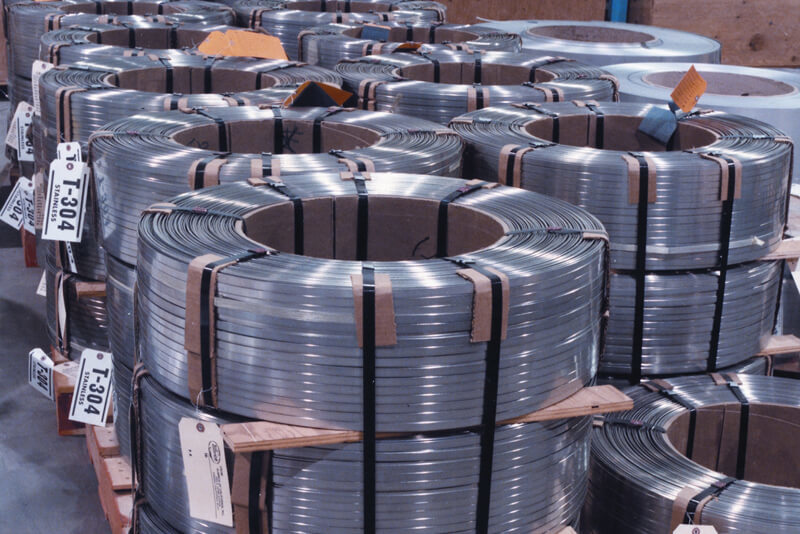Stainless steel does not rust due to its remarkable corrosion resistance due to the chromium it contains. Ferritic stainless steel is no exception. The main elements of ferritic stainless steel are chromium (≥10.5%) and iron. Some grades only contain chromium, and some grades contain other elements (such as Mo, Ti, Nb, etc.) in addition to chromium to obtain some special properties.
Ferritic stainless steels contain chromium and do not contain nickel, and the price of chromium has historically been relatively stable, making it less expensive and more stable than nickel-containing austenitic stainless steels.
Ferritic stainless steels have most of the mechanical properties and corrosion resistance of austenitic stainless steels, and also have many unique properties that are superior to austenitic stainless steels. Therefore, ferritic stainless steel can:
— as a complement to 304 stainless steel in the stainless steel family (304 is still the most widely used and most commonly used grade);
— Substitute for 200 series stainless steel (usually has better performance);
— Due to its special properties, it can replace other materials such as carbon steel, Cu, Zn, Al, plastics, etc. in many fields, and even in the field where only austenitic stainless steel can be used, it may become an excellent substitute material.
Users of ferritic stainless steels generally benefit from their technical performance and lower life cycle costs.
The "magnetism" of ferritic stainless steel is not "negative", but a special property that distinguishes it from other stainless steels.
The well known standard ferritic stainless steels 409, 410 and 430 are available worldwide. They are very successful in many important application areas such as washing machine drums, steam exhaust systems, etc. In fact, ferritic stainless steel has huge application potential in various fields.
Newly developed ferritic stainless steels such as 439, 441, 444, etc., can be used in a wider range of fields. They can be machined into complex shapes and joined and welded in the most common joining methods. Molybdenum-added ferritic stainless steel 444 is at least as resistant to localized corrosion as austenitic stainless steel 316.
Ferritic stainless steels are ideal materials due to their advantages in cost, properties and availability.

Five types of ferritic stainless steel
Ferritic stainless steel is divided into five categories, of which 1-3 are standard grades, and 4-5 are special grades. So far, the largest amount and the widest range of applications are mainly concentrated in standard steel grades. Therefore, standard ferritic stainless steels are generally fully capable of meeting and adapting to the requirements of most applications.
Class 1 - Cr content: 10%-14%. Typical grades 409, 410L.
This type of steel has the lowest chromium content of all stainless steels, is therefore the cheapest, and is most suitable for use in environments where there is no or slight corrosion and where slight localized rusting is permitted. Type 409 stainless steel was originally designed for automotive exhaust system mufflers (outside where corrosion is not severe). Type 410L stainless steel is commonly used in containers, buses and coaches, and more recently as an outer frame for liquid crystal displays.
Class 2 - Cr content: 14%-18%. Typical grade 430.
It is the most widely used type of ferritic stainless steel, contains higher chromium, has better corrosion resistance, and most of its properties are similar to 304. An alternative to Type 304 stainless steel in some applications, generally with adequate corrosion resistance for indoor use. Typical uses include washing machine drums, interior panels, etc. Typical 430 is often used as a 304 replacement material in kitchen facilities, dishwashers, pots and pans, etc.
Class 3 - Cr content: 14%-18%, including stabilizing elements Ti, Nb, etc. Typical grades 430Ti, 439, 441, etc.
Compared with class 2, this type of grade has good weldability and formability. In most cases, its performance is even better than 304. Typical uses include sinks, heat exchange pipes (sugar, energy, etc.), automotive exhaust systems (longer life than 409) and welds in washing machines. Category 3 grades can even replace 304 for higher performance applications.
Class 4 - Mo content above 0.5%;. Typical grades include 434, 436, 444, etc.
Typical applications for these grades are hot water tanks, solar water heaters, automotive exhaust systems, parts for electric kettles and microwave ovens, automotive trim strips and outdoor panels. The corrosion resistance of 444 stainless steel is comparable to that of 316 stainless steel.
Class 5 - Cr content: 18%-30%. Typical grades include 446, 445/447, etc.
These grades increase corrosion and oxidation resistance by adding more chromium and containing molybdenum. The corrosion resistance and oxidation resistance of these grades are better than 316. Typical Use Coastal and other highly corrosion resistant environments. The corrosion resistance of JIS447 is comparable to that of metal titanium.